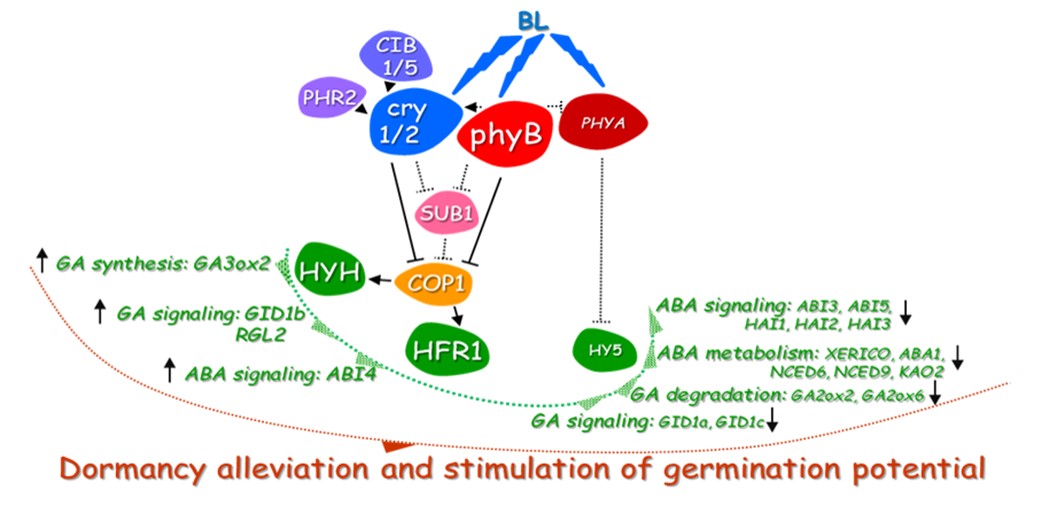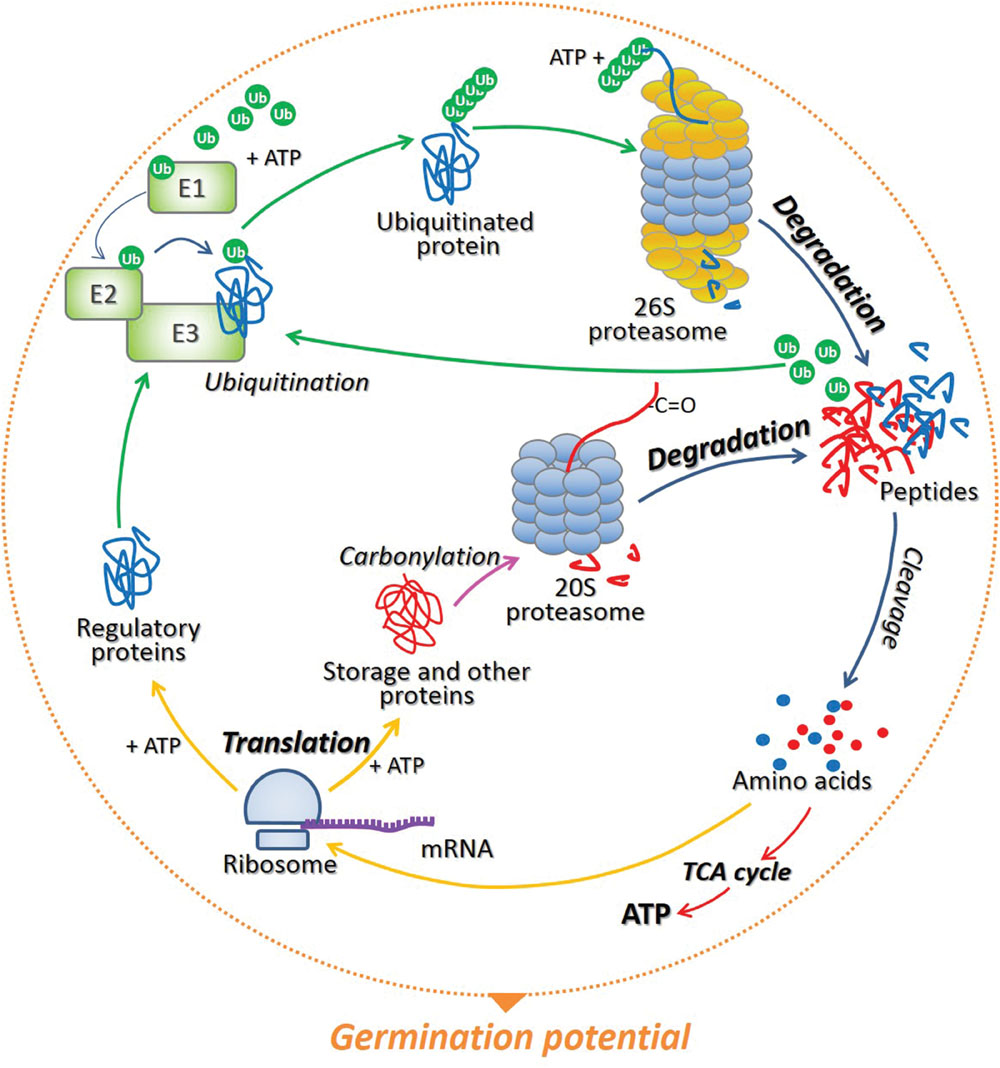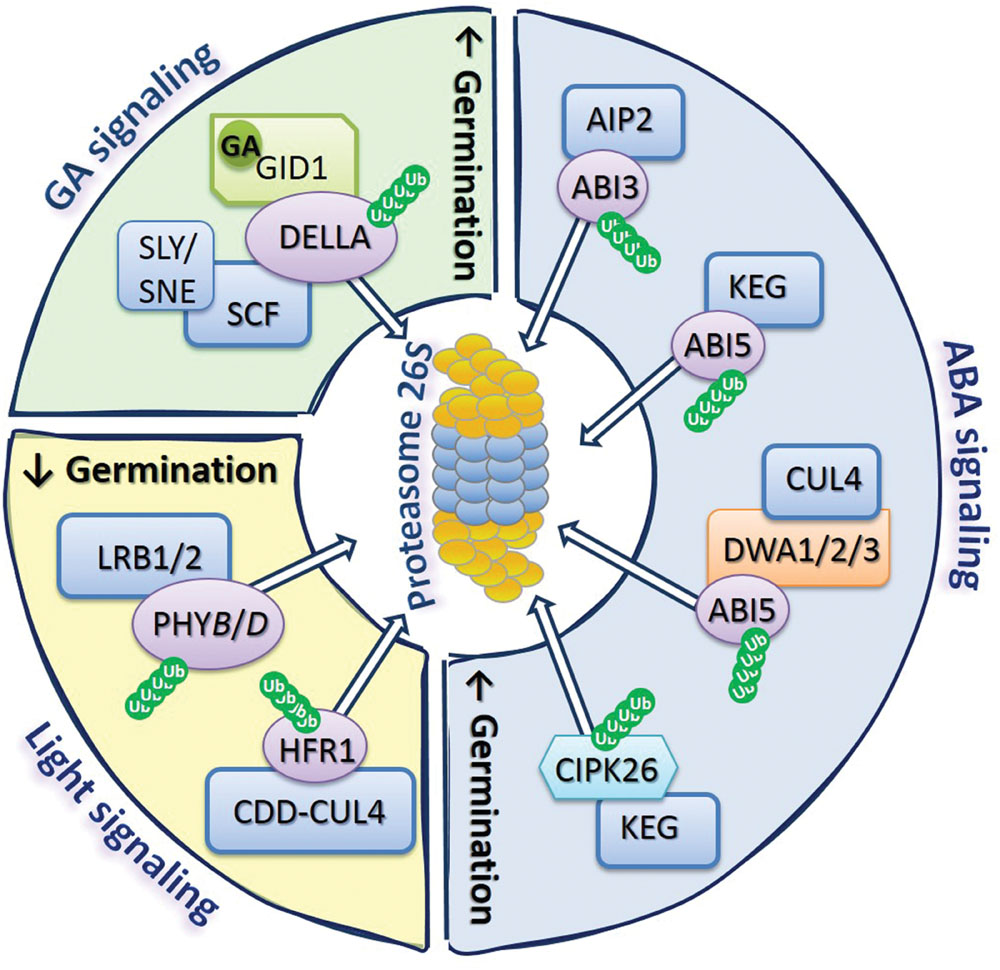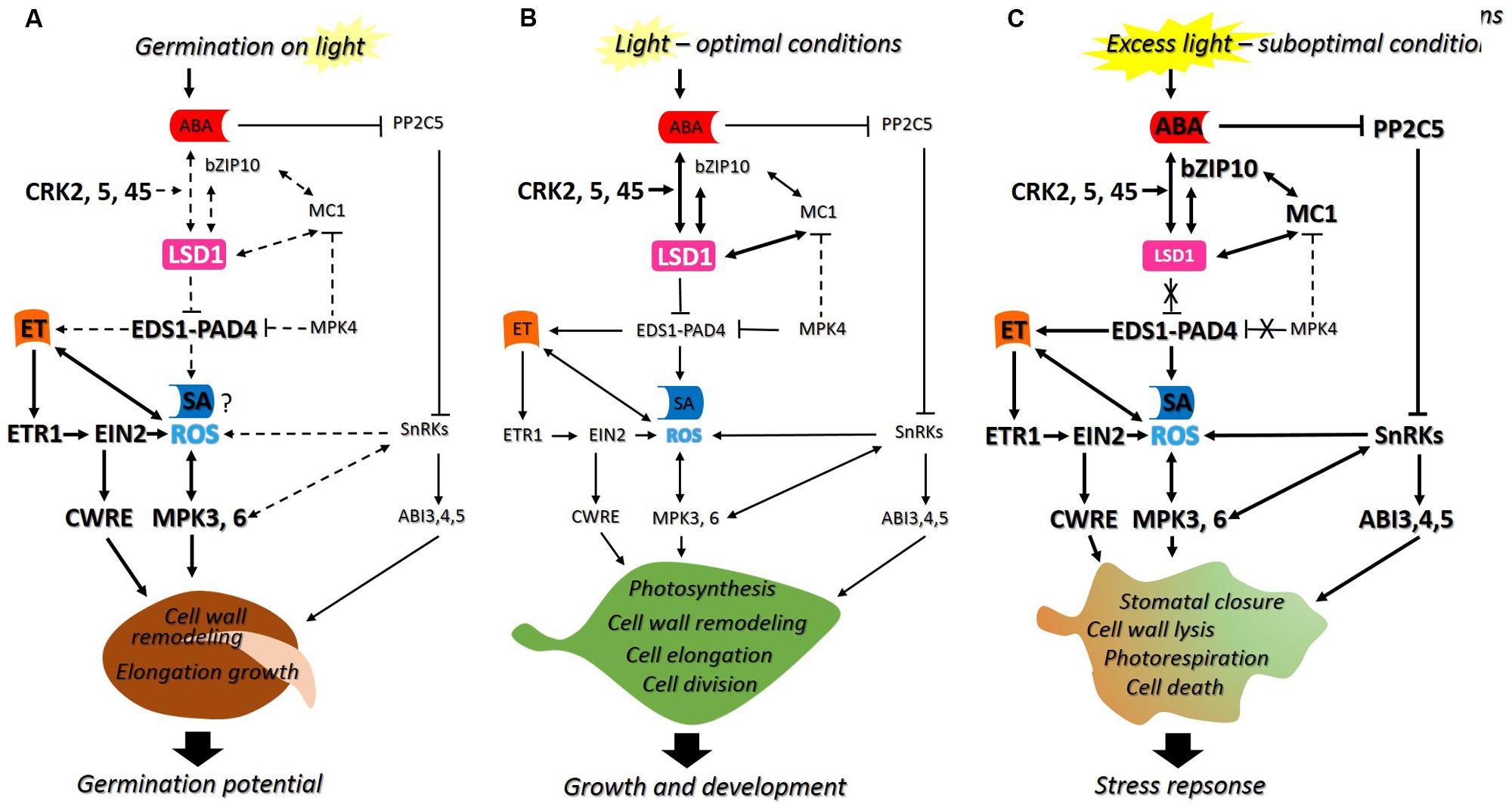| PhD Krystyna Oracz |
|
CONTACT: Phone: +48 22 59 325 35 Email: krystyna_oracz@sggw.edu.pl Email: oracz.krystyna@op.pl Krystyna Oracz (researchgate.net)
Actually, I am an Associate Professor in the Department of Plant Physiology, WULS-SGGW (Poland), leading the SeedExplorerGroup and managing my projects funded by grants of the National Science Centre and the Foundation for Polish Science. For the period of my scientific career I am fully aware about the important recent advances in seed biology. In my work I elucidate the molecular mechanisms of regulation of seed germination and dormancy, with a focus on the role of Reactive Oxygen Species (ROS) and phytohormones. My results provided a novel ROS-mediated mechanism for seed dormancy alleviation and thereby opened a new field in seed biology research. This mechanism involves a change in proteome oxidation, resulting from an accumulation of ROS during after-ripening. Hence, ROS accumulation appears to be a key signal governing cell activity during after-ripening (Oracz et al. 2007, Oracz et al. 2009). I have discovered also that the blue light release dormancy od dicot seeds and the mechanism involves modulation of GA, ABA and light related genes via phyB and HY5 dependent manner (Stawska and Oracz 2019). A major challenge of my recent projects and the most exciting aspects of the research performed in my research team is to elucidate: - the role of transcriptional and post-transcriptional regulation of gene expression in light- dependent germination of dormant A. thaliana seeds; - the protein turnover in seed-related processes (including regulation of translation and degradation of proteins); - the role of light and elements of light signaling pathway in seed-dormancy release and germination.
ONGOING PROJECT: OPUS12 National Science Centre (no. 2016/23/B/NZ3/03147) pt. ”Elucidation of the role of ARGONAUTE proteins in post-transcriptional regulation of gene expression in germinating seeds of Arabidopsis thaliana” (2017-2021).
ACADEMIC CAREER: Since November 2011 – Leader of the research team SeedExplorerGroup and the Assoc. Prof. at the Department of Plant Physiology, Warsaw University of Life Sciences - SGGW, Poland. 2012-2014 – Associate Prof. at the Department of Plant Genetics, Breeding and Biotechnology, at Warsaw University of Life Sciences - SGGW, Poland. 2009 – 2011 - postdoctoral researcher in Department of Molecular Plant Sciences, Albert Ludwigs University, Freiburg i. Br., Germany. May 2010 and Oct/Nov 2012 – research visit in EA2388 Physiologie des Semences, University Pierre and Marie Curie, Paris 6, France. December 2009 – research visit in the Faculty of Biological Sciences, University of Leeds, UK. March 2008 – March 2009 - postdoctoral researcher in Department of Molecular and Cell Biology, University of Cape Town, South Africa. February 2008 – Training Workshop „Building a Successful International Research Career”, for the special invitation of the British Council in Paris, France. February 2007 - research visit of PhD student in Royal Botanic Garden, Wakehurst Place, Kew, United Kingdom. November 2005 - research visit of PhD student in Centre National de la Recherche Scientifique, Bayer CropScience, Lyon, France. October 2003 – January 2008 - PhD studies (co-tutelle) in Plant Physiology Department, Warsaw University of Life Sciences (Poland) and in EA2388 Physiologie des Semences, Université Pierre et Marie Curie, Paris 6 (France). PDF of the polish-french PhD thesis is here. January 2002 – February 2002 - research stage of MSc student in EA2388 Physiologie des Semences, Université Pierre et Marie Curie, Paris 6 (France). October 1998 – July 2003 - B.S. and M.S. in plant physiology, Plant Physiology Department, Warsaw Agriculture University, Poland.
PROFESSIONAL ACTIVITIES: Since 2021 - the coordinator for the international cooperation at the Institute of Biology (WULS-SGGW) Współpraca międzynarodowa - Instytut Biologii (sggw.edu.pl) Since 2021 - the coordinator for the international cooperation and students exchange within a frame of ERASMUS+ programme at the Faculty of Biology and Biotechnology (WULS-SGGW) ERASMUS i sprawy zagraniczne - Wydział Biologii i Biotechnologii (sggw.edu.pl) Since 2019 - the coordinator for the international cooperation and students exchange within a frame of ERASMUS+ programme at the Faculty of Agriculture and Biology (WULS-SGGW) Students exchange (sggw.pl); International cooperation (sggw.pl) Since 2016 - member of the commission for the evaluation of internships carried out by students of biology at the Faculty of Agriculture and Biology, (WULS-SGGW) 2016-2019 - the coordinator for the students exchange within a frame of ERASMUS+ programme at the Faculty of Agriculture and Biology (WULS-SGGW) 2015-2019 - the secretary of the Plant Oxygen Group (http://www.plantoxygengroup.org/). Since May 2013 – the member of the Young Scientists’ Council at the Ministry of Science and Higher Education (Rada Młodych Naukowców http://rmn.org.pl/) Since 2013 - the contact person for the ERASMUS students exchange between WULS-SGGW (Warsaw, Poland) and UPMC (Paris, France) February 2012 – July 2013 – the coordinator of the Local Organizing Committee of the international conference „POG Warsaw 2013” (Plant Oxygen Group Society, www.pogwarsaw2013.org) Dr Oracz is an Expert for grant evaluation at the: National Sciecne Centre, Foundation for Polish Science, German Research Foundation. Dr Oracz is an Editor at journals: Frontiers in Plant Science, Seed Science Research. Member of the PFB – Polish Federation of Biotechnology Member of the POG - Plant Oxygen Group Member of the SHP – Societas Humboldtiana Polonorum Member of the Mission Club France en Pologne Member of the ISSS – International Society for Seed Science Member of the PTBER – Polskie Towarzystwo Biologii Eksperymentalnej Roślin
LIGHT SIGNALING PROJECT: „phyB and HY5 are involved in the BLUE light mediated alleviation of dormancy of Arabidopsis seeds possibly via the modulation of expression of genes related to light, GA, and ABA” Stawska and Oracz, Int. J. Mol. Sci., 2019, 20, 5882; doi:10.3390/ijms20235882 Light is one of the most important environmental factors regulating seed germination. It is known that light inhibits seed germination of some monocotyledonous species and that it is mostly related to the blue wavelength of the spectrum received by cryptochromes (cry). Research has also found that the red light (R) stimulates germination of dicotyledonous seeds and that this reaction involves mainly phytochromes (phy). Surprisingly, up to date, the role and the mechanism of action of blue light (BL) in seed biology of dicot plants is still very poorly understood and some questions are unexplained, e.g., whether BL plays a role in regulation of dicot seeds dormancy and/or germination? If, so what particular elements of light signaling pathway are involved in modulation of this(ese) process(es)? Also, is the BL action in regulation of dicot seeds dormancy and/or germination maybe due to changes of expression of genes related to metabolism and/or signaling of two phytohormones controlling seed-related events, such as gibberellins (GA) and abscisic acid (ABA)? To answer these intriguing questions, the combination of biological, transcriptomic, and genetic approaches was performed in this particular study. The germination tests show that freshly harvested wild type (WT) Arabidopsis thaliana Col-0 seeds are dormant and do not germinate in darkness (at 25 ◦C), while nondormant (after-ripened) seeds germinate well in these conditions. It is also proven that dormancy of seeds of this species is released in the presence of white and/or BL (λ = 447 nm) when placed at 25 ◦C. Presented here, novel results emphasize the role of BL in dormancy alleviation of dicot seeds, indicating that this wavelength of light spectrum received by phyB induces this process and that the sensitivity to this stimulus depends on the depth of seed dormancy. In addition, it is demonstrated that various elements of phy-mediated pathway can be used in response to the signal induced by BL in germinating dormant seeds of Arabidopsis. The quantitative real time PCR analysis supported by results of germination tests of WT, T-DNA insertion mutants (i.e., hy5, hfr1, and laf1) and overexpression transformants of Arabidopsis seeds (i.e., 35S:OE:HY5, 35S:OE:HYH, 35S:OE:HFR1, and 35S:OE:LAF1) revealed that the HY5 gene coding transcription factor is most probably responsible for the control of expression of genes involved in GA/ABA metabolism and/or signaling pathways during BL-dependent dormancy alleviation of Arabidopsis seeds, while biological functions of HYH and HFR1 are associated with regulation of germination. The model of BL action in regulation of dormancy alleviation and germination potential of Arabidopsis seeds is proposed.
The hypothetical model of BL action in regulation of dormancy alleviation and germination potential of dormant Arabidopsis seeds: The BL downregulates the expression of PHYA but not PHYB neither CRY1/2 photoreceptors. Decreased PHYA expression is associated with a possible low HY5 accumulation and/or its activity, leading to direct or indirect decrease in expression of genes encoding dormancy related genes. On the other hand, as the effect of BL illumination on the phyB and cry1/2 controlled by phyB, CIB1/5, and PHR2, the SUB1 and COP1 activity is suppressed, leading to HYH–- and HFR1-mediated activation of expression of specific genes involved in metabolism and signaling of GA and ABA, resulting in increase of germination potential. Dotted lines indicate hypothetical, possible interactions. Black arrows next to GA- and ABA-related genes indicate up- and downregulation (Stawska and Oracz Int. J. Mol. Sci. 2019, 20, 5882; doi:10.3390/ijms20235882). Funding: This research was funded by the National Science Centre (Poland), grant SONATA2 number: 2011/03/D/NZ9/04059, and grant PRELUDIUM12 (number 2016/23/N/NZ3/02239).
PROTEIN TURNOVER PROJECT: “Cellular recycling of proteins in seed dormancy alleviation and germination” Oracz and Stawska, Front. Plant Sci.(2016) https://doi.org/10.3389/fpls.2016.01128 Each step of the seed-to-seed cycle of plant development including seed germination is characterized by a specific set of proteins. The continual renewal and/or replacement of these biomolecules are crucial for optimal plant adaptation. As proteins are the main effectors inside the cells, their levels need to be tightly regulated. This is partially achieved by specific proteolytic pathways via multicatalytic protease complexes defined as 20S and 26S proteasomes. In plants, the 20S proteasome is responsible for degradation of carbonylated proteins, while the 26S being a part of ubiquitin-proteasome pathway is known to be involved in proteolysis of phytohormone signaling regulators.
Figure 1. The model of protein recycling in cells of germinating seeds. During translation preformed on ribosomes associated with particular mRNAs, a wide range of proteins are synthetized, and the energy in the form of ATP is required for this process. The specific regulatory proteins which have completed their mission in various cellular processes can be polyubiquitinated by the cascade of three enzymes E1, E2, and E3. The attachment of at least 4 ubiquitin (Ub) molecules target proteins for proteolysis via 26S proteasome in an ATP-dependent manner. As soon as the substrate is degraded, Ub are released and can be reused in the labeling and degradation of another target protein. On the contrary, storage and other (e.g., damaged) proteins, which are irreversibly oxidized (carbonylated) during seed germination, undergo ATP- and Ub-independent degradation by 20S proteasome. Short peptides resulting from proteasomal proteolysis are then cleaved by the peptidases to single amino acids, which then can be re-used by complexes of ribosomes and mRNA during de novo protein biosynthesis and/or used in the citric acid cycle (TCA) to generate energy – ATP. The balance between protein synthesis and degradation determines the germination potential of the seed (Oracz and Stawska, Front. Plant Sci., 2016, https://doi.org/10.3389/fpls.2016.01128). On the other hand, the role of translational control of plant development is also well-documented, especially in the context of pollen tube growth and light signaling. Despite the current progress that has been made in seed biology, the sequence of cellular events that determine if the seed can germinate or not are still far from complete understanding. The role and mechanisms of regulation of proteome composition during processes occurring in the plant’s photosynthetic tissues have been well-characterized since many years, but in non-photosynthetic seeds it has emerged as a tempting research task only since the last decade. This review discusses the recent discoveries providing insights into the role of protein turnover in seed dormancy alleviation, and germination, with a focus on the control of translation and proteasomal proteolysis.
Figure 2. The 26S proteasome as a regulatory hub of GA, ABA, and light signaling. The complex of proteases called as the proteasome 26S together with various types of E3 ligases ubiquitinating target proteins are key components of the mechanism controlling accumulation of regulatory proteins involved in GA, ABA, and light signaling pathways, determining the germination potential of the seed. Proteasome modulate GA signaling by degradation of DELLA proteins, which in the presence of GA can bind to GID1 receptors and SCF complex resulting in DELLA ubiquitination, allowing recognition of targeted proteins by the 26S complex. ABA signaling is controlled by the degradation of ABI3 and ABI5 transcription factors, as well as CIPK26 regulatory proteins, by 26S proteasome after ubiquitination of these proteins by different types of E3 ligases, such as AIP2, KEG, and CUL4. Light signal perception by germinating seeds rely mostly on the modulation of abundance of PHYB, which depends on the activity of CDD-CUL4 ligase complex, as well as LRB1/2 regulatory proteins allowing ubiquitination of PHYB and degradation by 26S proteasome. Degradation of regulatory proteins involved in GA and ABA signaling leads to stimulation of germination, while degradation of regulators of light signaling affects germination (indicated by up- or down-oriented arrows). Ub, ubiquitin (Oracz and Stawska, Front. Plant Sci., 2016, https://doi.org/10.3389/fpls.2016.01128). The presented novel data of translatome profiling in seeds highlighted that post-transcriptional regulation of germination results from a timely regulated initiation of translation. In addition, the importance of 26S proteasome in the degradation of regulatory elements of cellular signaling and that of the 20S complex in proteolysis of specific carbonylated proteins in hormonal- and light-dependent processes occurring in seeds is discussed. Based on the current knowledge the model of cellular recycling of proteins in germinating seeds is also proposed. Funding: Krystyna Oracz and Marlena Stawska are grateful for the financial support from the HOMING PLUS/2012-5/10 grant of the Foundation for Polish Science.
ROS and phytohormones interactions project: “Phytohormones signaling pathways and ROS involvement in seed germination” Oracz and Karpiński, Front. Plant Sci. (2016) https://doi.org/10.3389/fpls.2016.00864 Phytohormones and reactive oxygen species (ROS) are major determinants of the regulation of development and stress responses in plants. During life cycle of these organisms, signaling networks of plant growth regulators and ROS interact in order to render an appropriate developmental and environmental response. In plant’s photosynthetic (e.g., leaves) and non-photosynthetic (e.g., seeds) tissues, enhanced and suboptimal ROS production is usually associated with stress, which in extreme cases can be lethal to cells, a whole organ or even an organism. However, controlled production of ROS is appreciated for cellular signaling. Despite the current progress that has been made in plant biology and increasing number of findings that have revealed roles of ROS and hormonal signaling in germination, some questions still arise, e.g., what are the downstream protein targets modified by ROS enabling stimulus-specific cellular responses of the seed? Or which molecular regulators allow ROS/phytohormones interactions and what is their function in seed life? In this particular review the role of some transcription factors, kinases and phosphatases is discussed, especially those which usually known to be involved in ROS and hormonal signal transduction under stress in plants, may also play a role in the regulation of processes occurring in seeds. The summarized recent findings regarding particular ROS- and phytohormones-related regulatory proteins, as well as their integration, allowed to propose a novel, possible model of action of LESION SIMULATING DISEASE 1, ENHANCED DISEASE SUSCEPTIBILITY 1, and PHYTOALEXIN DEFICIENT 4 functioning during seeds life.
Figure 1. The proposed model of action of LESION SIMULATING DISEASE 1 (LSD1), ENHANCED DISEASE SUSCEPTIBILITY 1–PHYTOALEXIN DEFICIENT 4 (EDS1–PAD4) and other molecular regulators: (A) during seed germination in light, as well as in foliar tissues exposed to (B) optimal or (C) suboptimal conditions. LSD1 is a negative regulator of cell death and suppresses EDS1–PAD4 in laboratory conditions. This regulatory hub integrates signals induced by reactive oxygen species (ROS) and phytohormones [abscisic acid (ABA), ethylene (ET), and salicylic acid (SA)] during plants growth and development. It is highlighted that the mechanism of action of LSD1 and EDS1–PAD4 is conditionally regulated. In seeds imbibing in the presence of light, LSD1 suppresses EDS1–PAD4, thus it prevents cell death and promotes cell wall remodeling required for cell elongation of radicle during germination (A). In plants growing in optimal conditions the inhibition of EDS1–PAD4 by LSD1 results in positive modulation of photosynthesis, cell wall remodeling, elongation, and division of cells crucial for proper growth and development (B). The perturbations in photosynthetic tissue caused by suboptimal conditions lead to limitations of LSD1 suppression effect on EDS1–PAD4, resulting in induction of stress response and acclimation achieved by modulation of stomatal closure, photorespiration, cell wall lysis and cell death (C). The dotted lines indicate possible interactions (not yet confirmed). The size of letters and thickness of arrows reflects to the effect (increase/decrease) of particular interactions between regulators. (Oracz and Karpiński, Front. Plant Sci., (2016) https://doi.org/10.3389/fpls.2016.00864
PUBLICATIONS:
Pawłasek N, Sokołowska A, Koter M, Oracz K (2024). The interaction between miR165/166 and miR160 regulates Arabidopsis thaliana seed size, weight, and number in a ROS-dependent manner. Planta 260:72, doi.org/10.1007/s00425-024-04499-8 Sokołowska A, Rugała M, Oracz K (2022). Białka ARGONAUT w biologii komórki i rozwoju roślin. Postępy Biochemii, doi: 10.18388/pb.2021_450 Meng Y, Ma X, Li J, Ito H, Oracz K, Cai J, Shao C (2022). The novel activity of Argonautes in intron splicing: A transcriptome-wide survey in plants. Journal of Plant Physiology 270: 153632, doi: 10.1016/j.jplph.2022.153632 Lindermayr C, Oracz K, Cuypers A, Schnitzler J-P and Durner J (2021). Editorial: Highlights of POG 2019 - Plant Oxygen Group Conference. Frontiers in Plant Science 12: 639262, doi: 10.3389/fpls.2021.639262 Stawska M, Oracz K (2019). phyB and HY5 are Involved in the Blue Light-Mediated Alleviation of Dormancy of Arabidopsis Seeds Possibly via the Modulation of Expression of Genes Related to Light, GA, and ABA. International Journal of Molecular Sciences 20; 5882, doi:10.3390/ijms20235882 (PDF) Stawska M, Zdzieszyńska J, Walczuk E, Oracz K (2018). Biologiczne funkcje oksydaz NADPH w komórce roślinnej. Postępy Biologii Komórki 45 (1): 25-44. (PDF) Oracz K and Stawska M (2016). Cellular recycling of proteins in seed dormancy alleviation and germination. Front. Plant Sci. 7:1128. doi: 10.3389/fpls.2016.01128 (PDF)
AWARDS, DISTINCTIONS, SCHOLARSHIPS: The Award of the Rector of WULS-SGGW for outstanding scientific and didactic achievements of PhD Krystyna Oracz, which have a significant influence on the development, promotion and prestige of WULS-SGGW (Apr 2020'). The Award of the Rector of WULS-SGGW for outstanding scientific and didactic achievements of PhD Krystyna Oracz, which have a significant influence on the development, promotion and prestige of WULS-SGGW (Apr 2017'). The Distinction of the Rector of WULS-SGGW for the scientific achievements of PhD Krystyna Oracz (Sept 2016'). The Distinction of the Rector of WULS-SGGW for the organizing activity of PhD Krystyna Oracz (Sept 2014'). The Diplomas for the best oral talk: “PROTEASOME PROTEIN LEVEL AND ITS ACTIVITY ARE IMPORTANT FOR MODULATION OF SEED DORMANCY ALLEVIATION” M. Stawska, P. Topolewski, K. Oracz, and poster presentation: “THE GROWTH POTENTIAL OF GERMINATING SEEDS DEPENDS ON THE PROTEASOME” M. Stawska, P. Topolewski, K. Oracz, for MSc M. Stawska (a student of PhD K. Oracz) presenting results during the "5th International Conference for PhD Students - Multidirectional Research in Agriculture and Forestry", which was held on the 16th-17th April 2016’ in Cracow, Poland. To view a diploma please click here: diploma for oral presentation, diploma for poster presentation. The Best Oral Presentation Award for MSc M. Stawska - a PhD student of Dr K. Oracz, presenting results during the "12th International Conference on Reactive Oxygen and Nitrogen Species in Plants: from model systems to field", which was held on the 24th-26th June 2015’ in Verona, Italy. To view a diploma please click here: diploma The Diploma for the best oral talk for MSc M. Stawska (a student of PhD K. Oracz) presenting results during the "4th International Conference for PhD Students - Multidirectional Research in Agriculture and Forestry", which was held on the 21st-22nd March 2015’ in Cracow, Poland. To view a diploma please click here: diploma for oral presentation. The results obtained in the SeedExplorerGroup, presented in oral and poster presentations by MSc Marlena Stawska – a student of PhD K. Oracz were awarded at the "11th Conference of the International Society for Seed Science", which was held on the 15th-19th Sept 2014’ in Changsha, China. To view diplomas please click here: diploma for poster, diploma for oral presentation. Scholarship of the Ministry of Science and Higher Education for the outstanding young scientist (2012-2015). Bourse du Gouvernement Français «Séjour de recherche» - fellowship of the realization of the research stage in EA2388 Physiologie des Semences, Uniwersity of Pierre and Marie Curie, Paris, France (2012) Grant Wissenschaftlichen Gesellschaft – financial support for the research Freiburg im Breisgau, Germany (2011). Grant Wissenschaftlichen Gesellschaft – financial support for the research, Freiburg im Breisgau, Germany (2010). Alexander von Humboldt Fellowship – for the realization of postdoc in the Department of Molecular Plant Sciences, University of Freiburg, Freiburg i. Br., Germany (2009). The ISSS President’s Prize for the best Poster presentation by the title: “Signaling role of HCN and ROS in alleviation of sunflower embryo dormancy”. 9th ISSS Conference on Seed Biology, Olsztyn, Poland (2008). Claude Leon Foundation Fellowship – for the realization of postdoc in the Department of Molecular and Cell Biology at University of Cape Town, Cape Town, South Africa (2008). Distinction of the PhD degree entitled: "Role of hydrogen cyanide in dormancy removal of sunflower (Helianthus annuus L.) embryos", Warsaw/Paris, Poland/France (2008). Foundation for Polish Research – grant supporting participation in “2nd ISSS Workshop on Molecular Aspects of Seed Dormancy and Germination” in Salamanca, Spain (2007). Award in the category - the best oral presentation and very interesting results presented at 3rd Conference of Polish Society of Experimental Plant Biology (Warsaw, Poland), by the title: “Possible interplay of HCN and ROS with ethylene signalling pathway in alleviation of sunflower embryos dormancy” (2007). French Government Grant – for the realization of co-tutelle (Polish-French) PhD thesis, French Embassy in Warsaw, Poland (2004). Award of President of Warsaw Town – for one of the best students of Warsaw universities, Warsaw, Poland (2003). III prize in the category - the best oral presentation by the title: “Allelopathic potential of sunflower. IV. Activation of antioxidative system in germinating mustard (Sinapis alba L.)”, 5th International Conference: Ecophysiological aspects of plant responses to stress factors, Cracow, Poland (2003). Distinction of master degree by the title: “Oxidative stress in germinating mustard (Sinapis alba L.) seeds during allelopathy stress”, Warsaw, Poland (2003). Bronze Award considered as one of the best posters presented in the III World Congress on Allelopathy, Tsukuba, Japan (2002). |








